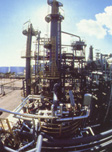










![]()
![]()
![]()
![]()
Webdesign by
Silent Noise
Special missions
Bostrom's performs special missions in "hazardous environments" such as diving in warm crude oil, gasoline, sludge, in pipes etc. We climb into caves, crevasses, and crawl into pipes and channels for different emergencies, We provide educations in personal safety, industrial safety, chemical diving, chemical health hazards, emergency health care, weapons and explosives. We test safety in plants, industries and communities and we do special securitywork. We provide transportation for police departements in cases of "search and seizure". We take care of dead animals and clean up after dead animals or people. We clean cisterns from chemicals, petroleum products, sludge etc. We do risk and consequence analyses and form contracts for damage control and salvage with industries, national and local authorities, realty companies, private companies etc.
Working in refinerys or nuclear powerplants
To work in a refinery or nuclear power plant is very special, and requires extremely thorough preparation, safety planning, special equipment and especially chosen and trained personnel. We dismantle and clean reactors, boilers, towers, pipelines and pumps for different types of combustible liquids and gases etc. We seal and decontaminate aher leaks or overflows as well as clean up polluted ground, examine and clean polluted water, demolish and clean up after fires, dive in pools, water inlets, pipes etc.
Working in sedementation tanks
This is "dirty work" that is not without risks. Explosions, overheating and the danger of being sucked down and stuck in the sediment are only a few of the risks that exist. We clean, purge and dive into these problem areas for different tasks.
Working in silos
This type of work is similar to that described above for sedimentation tanks. The tasks vary, from assisting rescue teams on life-saving missions, investigations for police departments, salvaging objects dropped in a silo that is either empty or contains milkpowder, cement, flour or grain, or that is filled with nitrogen, ensilage (feed), to removing blockages or "plugs" in the silos or putting out fires inside silo installations, soot filters, drums, channels etc.
Firearms
The use of firearms in the rescue service is relatively new in Sweden, if you exclude the shooting that the police and hunters do in connection with barn fires or other animal emergency work. Shooting at hazardous gas cylinders is, for example, one method of quickly preventing the danger of explosion, which has become popular within the rescue services. Shooting a gas cylinder in connection with or after a fire is an excellent method of minimizing the effort and making a hazardous area safe. Shooting is however, not the only, but just to have one of several methods that can be used to defuse the threat of an uncontrolled explosion. In order to shoot a gas cylinder you have properly equipped and trained personnel, suitable weapons and sights, as well as special ammunition. In other words, you need a powerful ammunition that has the ability to penetrate the gascontainer and make as large a hole as possible. You therefore need large calibre ammunition, fuII metal jacketed as well as tracer and/or armor piercing ammunition, in order to resolve most situations where you need to shoot hazardous gas cylinders. The marksman needs special equipment for his own personal safety. Puncturing hazardous chemical containers is also something new for the rescue service. We have for some rescue services and other authorities, industries etc. tried this and found that it can be an excellent method, but that it requires a little more knowledge, as well as selected weapons and ammunition. Special high-penetration ammunition with several projectiles in each shot, means that one can achieve a quick reduction of pressure in the barrel, container, bottle, tank or cistern. Special ammunition of a very large calibre, is one way to penetrate barrels etc. in order to reach internal pockets of gas. Advanced planning of such shooting is extremely important and possible secondary factors or sideeffects must be taken into account in the total risk evalution. To shoot animals in emergency situations difficuIt and requires special training and ammunition, as no two situations are alike. It can be a question of shooting at close range, in smoke, under the threat of landslides and stressfuI situations with different types of animals. On a mission to destroy animals in emergency situations such as fire, traffic accidents etc. Bostrom's always has different types of weapons and ammunition at hand. The alternative of immobilising an animal can also be advantageous if you have the know-how and equipment for the task, such as the right drugs, stun guns, a blowgun, rod-mounted injection devices etc.
Explosives
The use of explosives in modern emergency rescue service is rather new in Sweden, and limited experimental operations have been conducted during 1993 and 1994 at a few chosen rescue squads, in cooperation with among others, the Swedish Rescue Agency and an explosives manufacturer. One area of use for demolition technology in the rescue services is, for example, blasting holes in the roofs of buildings that are on fire in order to obtain the advantage of quick ventilation of trapped combustible gases. We have been doing this for approximately 9 years now, up until 1994, and have developed a number of methods with new technology and inexpensive explosies which are easy and safe to use and can be molded and adjusted according to the requirements of the situation. In other words; adjusted according to the desired size of the hole, roofing material, explosive force etc. Demolition of ice, buildings, constructions etc. are other areas of use that require a little more knowledge and different equipment. Demolition at sites of traffic accidents, plane, train or ship crashes has become more common and efficient, but requires different types of equipment, competence, permits and insurance.
